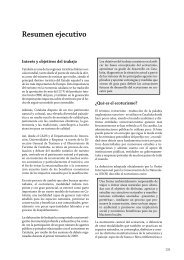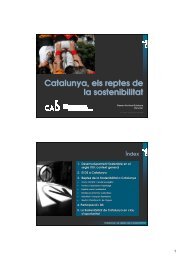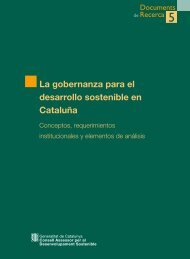Estratègies per al desenvolupament sostenible - Generalitat de ...
Estratègies per al desenvolupament sostenible - Generalitat de ...
Estratègies per al desenvolupament sostenible - Generalitat de ...
You also want an ePaper? Increase the reach of your titles
YUMPU automatically turns print PDFs into web optimized ePapers that Google loves.
and nation<strong>al</strong> sc<strong>al</strong>e it will require participatory and transvers<strong>al</strong> institutions andmechanisms of integration that commit governments, civil society and the privatesector in the <strong>de</strong>velopment of outlooks, plans and <strong>de</strong>cisions. All these agents mustbe more open and responsible for their actions. All these factors require a strategicapproach.Many recently attempted strategies have failed for one of the following reasons:They were not inten<strong>de</strong>d to and were not able to be integrated into the planningsystem currently o<strong>per</strong>ative; they worked in isolation and were of secondaryimportance and did not attain the required efficiency. A strategy of sustainable<strong>de</strong>velopment is not just another strategy or plan, but an area and a process capableof integrating and of being integrated into existing strategies and plans.Many were not true strategies but were lists (often very well drawn up) of <strong>de</strong>siresthat lacked the necessary specification of strategic objectives, duly formulatedgo<strong>al</strong>s, and specific well-committed and budgeted action. A strategy is not a listof everything that has to be done, but is rather a selection of objectives, go<strong>al</strong>s andactions, chosen from those that are possible. It is not a technic<strong>al</strong> but a truly politic<strong>al</strong>plan to which technicians may contribute.Many were drawn up on a basis of insufficient participation. They were unable tocommit the private sector and the soci<strong>al</strong> organisations that were necessary toachieve each objective and ex<strong>per</strong>ienced that government<strong>al</strong> action <strong>al</strong>one is notenough.Others failed because they did not support existing processes, strategies andcapacities, but were an attempt to start something different and new withoutconsi<strong>de</strong>ration for existing forces and capacities.Being strategic means setting forth an outlook by means of a dynamic, effective andconsensu<strong>al</strong> process; it means establishing objectives and i<strong>de</strong>ntifying the means toachieve them, organising monitoring and ev<strong>al</strong>uation and making the whole processa system of learning. Being strategic requires an un<strong>de</strong>rstanding of the integratednature of sustainable <strong>de</strong>velopment, yet not un<strong>de</strong>rtaking a commitment to a completeseries of actions with the assumption they <strong>al</strong>l may be <strong>per</strong>formed at once. The keylies in knowing how to find <strong>al</strong>l the openings that enable steps forward to be takentowards sustainability. For <strong>al</strong>l these reasons, a strategic approach to sustainable<strong>de</strong>velopment involves new ways of thinking and of working. It particularly requires:131
















